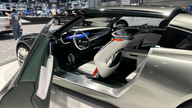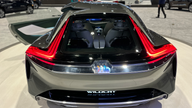Buick Gets Wild at the 2023 Chicago Auto Show with the Wildcat Concept
- Cory Fourniquet

- Feb 11, 2023
- 2 min read
For nearly 70 years, the Wildcat name has been reserved for innovative, progressive Buick concept vehicles that push the boundaries of design and technology. Like the new Wildcat EV concept, the first Wildcat - introduced in 1953 - was a show vehicle that previewed next-generation Buick design. The Wildcat II and III concepts followed in 1954 and 1955, respectively, and the designs of all were overseen by legendary chief designer Harley Earl. In 1985, another Wildcat concept debuted. It was a futuristically styled, mid-engine and AWD supercar developed to showcase new engine technologies.

Debuting in June of 2022 along with the new version of the brand's try-shield logo, the Wildcat serves as the beacon for a new design direction for the company. Looking to take on established luxury brands like Lexus and Acura, this new design philosophy definitely draws attention as we were never alone next to this concept at the Chicago Auto Show. It always had a crowd around it with their cameras and cell phones out.
This concept is their proof of concept that the Buick brand can be relevant and intriguing as the brand pivots to an all-electric future by the end of the decade. This is the first electric Buick model we have seen, and the brand's 3 current models are all gas-only. Given this, we should see some big and swift changes at the Buick brand very soon if they aim to meet their goal.
Inside, the Wildcat EV concept's cabin has an inner glow that is inviting and comforting, all while integrating new technologies designed to make the riding experience more enjoyable.
"It's a space intended to strike an emotional chord," said Therese Pinazzo, Buick exterior and interior design manager. "It is defined by simple, graceful forms that convey balance, harmony and a feeling of warmth."
The 2+2 configuration, delineated by a prominent console that extends from the base of the instrument panel to the rear seating area, uses unique graphic and color contrasts to create the perception of visually floating elements intended to accentuate the cabin's lightweight feel and spaciousness.
Color plays an important role in the warmth and comfort the interior conveys. Legato Green flows through the cabin and is accented with brushed or polished aluminum trim. Lively orange elements, including the seat belts, also add visual distinction.
Additional interior design elements include cockpit-style seats with cantilevered headrests that appear to be floating, and a lightweight, flat-bottom steering wheel.
When it comes to technology integration and infotainment interaction, a sweeping touchscreen is the access point on the instrument panel, along with a complementing screen on the console.
The Wildcat EV concept is built to be a platform for futuristic features such as artificial intelligence, biometrics and aromatherapy. The vehicle is designed to detect an elevation in driver heart rate and automatically adjust vehicle settings to calm them down. For example, when Zen Mode is activated, it will dim the cabin lights, disperse calming aromatherapy scents and activate massaging seats.
If you want to see this for yourself, you will need to act fast as it will only be at the Chicago Auto Show for the opening weekend: February 11-12.
































































































Comentarios